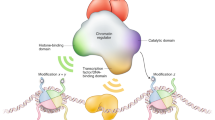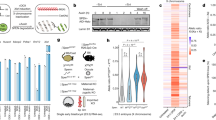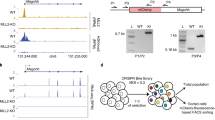Abstract
Runx family proteins have the potential for either activating or suppressing gene expression in a context-dependent manner. There are several mechanisms by which transcriptional repression can occur. A wide range of locus inactivation, that is often called gene silencing, is thought to be achieved by chromatin modifications. Recently, Runx family proteins were found to have an essential role in either temporal transcriptional repression or irreversible epigenetic silencing at the CD4 locus through binding to a CD4 silencer at different stages of development. These findings link Runx function to epigenetic gene regulation, and shed new light on the mechanisms by which Runx represses target gene expression.
This is a preview of subscription content, access via your institution
Access options
Subscribe to this journal
Receive 50 print issues and online access
$259.00 per year
only $5.18 per issue
Buy this article
- Purchase on Springer Link
- Instant access to full article PDF
Prices may be subject to local taxes which are calculated during checkout

Similar content being viewed by others
References
Chakraborty S, Sinha KK, Senyuk V and Nucifora G . (2003). Oncogene, 22, 5229–5237.
Chi TH, Wan M, Zhao K, Taniuchi I, Chen L, Littman DR and Crabtree GR . (2002). Nature, 418, 195–199.
Donda A, Schulz M, Burki K, De Libero G and Uematsu Y . (1996). Eur. J. Immunol., 26, 493–500.
Ellmeier W, Sawada S and Littman DR . (1999). Annu. Rev. Immunol., 17, 523–554.
Ellmeier W, Sunshine MJ, Maschek R and Littman DR . (2002). Immunity, 16, 623–634.
Festenstein R and Kioussis D . (2000). Curr. Opin. Genet. Dev., 10, 199–203.
Festenstein R, Sharghi-Namini S, Fox M, Roderick K, Tolaini M, Norton T, Saveliev A, Kioussis D and Singh P . (1999). Nat. Genet., 23, 457–461.
Garefalaki A, Coles M, Hirschberg S, Mavria G, Norton T, Hostert A and Kioussis D . (2002). Immunity, 16, 635–647.
Jain M, Arvanitis C, Chu K, Dewey W, Leonhardt E, Trinh M, Sundberg CD, Bishop JM and Felsher DW . (2002). Science, 297, 102–104.
Jenuwein T and Allis CD . (2001). Science, 293, 1074–1080.
Kioussis D and Ellmeier W . (2002). Nat. Rev. Immunol., 2, 909–919.
Lapidot T, Sirard C, Vormoor J, Murdoch B, Hoang T, Caceres-Cortes J, Minden M, Paterson B, Caligiuri MA and Dick JE . (1994). Nature, 367, 645–648.
Leung RK, Thomson K, Gallimore A, Jones E, Van den Broek M, Sierro S, Alsheikhly AR, McMichael A and Rahemtulla A . (2001). Nat. Immunol., 2, 1167–1173.
Levanon D, Goldstein RE, Bernstein Y, Tang H, Goldenberg D, Stifani S, Paroush Z and Groner Y . (1998). Proc. Natl. Acad. Sci. USA, 95, 11590–11595.
Lutterbach B, Westendorf JJ, Linggi B, Isaac S, Seto E and Hiebert SW . (2000). J. Biol. Chem., 275, 651–656.
Miyoshi H, Shimizu K, Kozu T, Maseki N, Kaneko Y and Ohki M . (1991). Proc. Natl. Acad. Sci. USA, 88, 10431–10434.
Nakayama J, Rice JC, Strahl BD, Allis CD and Grewal SI . (2001). Science, 292, 110–113.
Nielsen SJ, Schneider R, Bauer UM, Bannister AJ, Morrison A, O'Carroll D, Firestein R, Cleary M, Jenuwein T, Herrera RE and Kouzarides T . (2001). Nature, 412, 561–565.
Osato M, Asou N, Abdalla E, Hoshino K, Yamasaki H, Okubo T, Suzushima H, Takatsuki K, Kanno T, Shigesada K and Ito Y . (1999). Blood, 93, 1817–1824.
Satake M, Nomura S, Yamaguchi-Iwai Y, Takahama Y, Hashimoto Y, Niki M, Kitamura Y and Ito Y . (1995). Mol. Cell. Biol., 15, 1662–1670.
Sawada S, Scarborough JD, Killeen N and Littman DR . (1994). Cell, 77, 917–929.
Sebzda E, Mariathasan S, Ohteki T, Jones R, Bachmann MF and Ohashi PS . (1999). Annu. Rev. Immunol., 17, 829–874.
Siu G, Wurster AL, Duncan DD, Soliman TM and Hedrick SM . (1994). EMBO J., 13, 3570–3579.
Taniuchi I, Ellmeier W and Littman DR . (2004). Adv. Immunol., in press.
Taniuchi I, Osato M, Egawa T, Sunshine MJ, Bae SC, Komori T, Ito Y and Littman DR . (2002a). Cell, 111, 621–633.
Taniuchi I, Sunshine MJ, Festenstein R and Littman DR . (2002b). Mol. Cell, 10, 1083–1096.
von Boehmer H, Swat W and Kisielow P . (1993). Immunol. Rev., 135, 67–79.
Wakimoto BT . (1998). Cell, 93, 321–324.
Wheeler JC, Shigesada K, Gergen JP and Ito Y . (2000). Semin. Cell Dev. Biol., 11, 369–375.
Woolf E, Xiao C, Fainaru O, Lotem J, Rosen D, Negreanu V, Bernstein Y, Goldenberg D, Brenner O, Berke G, Levanon D and Groner Y . (2003). Proc. Natl. Acad. Sci. USA, 100, 7731–7736.
Zou YR, Sunshine MJ, Taniuchi I, Hatam F, Killeen N and Littman DR . (2001). Nat. Genet., 29, 332–336.
Author information
Authors and Affiliations
Corresponding author
Rights and permissions
About this article
Cite this article
Taniuchi, I., Littman, D. Epigenetic gene silencing by Runx proteins. Oncogene 23, 4341–4345 (2004). https://doi.org/10.1038/sj.onc.1207671
Published:
Issue Date:
DOI: https://doi.org/10.1038/sj.onc.1207671
Keywords
This article is cited by
-
RUNX1 meets MLL: epigenetic regulation of hematopoiesis by two leukemia genes
Leukemia (2013)
-
RUNX proteins in transcription factor networks that regulate T-cell lineage choice
Nature Reviews Immunology (2009)
-
Themis is a member of a new metazoan gene family and is required for the completion of thymocyte positive selection
Nature Immunology (2009)
-
Runx-CBFβ complexes control expression of the transcription factor Foxp3 in regulatory T cells
Nature Immunology (2009)
-
Interactions among the transcription factors Runx1, RORγt and Foxp3 regulate the differentiation of interleukin 17–producing T cells
Nature Immunology (2008)



